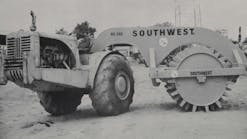The next time the hydraulics are giving you a problem on your excavator, take a moment to give thanks for just how far excavator design has come.
The advantages of being able to dig below grade with a steam shovel were recognized in the days when these shovels were confined to rails and could only swing left or right. The means of doing this could be quite ingenious, if unwieldy. This is one of the simpler arrangements.
Berry is archivist for the Historical Construction Equipment Association. For more information, visit www.hcea.net.
Fitted to a Barnhart Style AA railroad shovel, this was one of the first predecessors to today’s hydraulic excavators. The digging action is precisely the same as a hydraulic excavator, albeit powered by cables and lacking any down pressure; the bucket was lowered into the cut and then drawn up and back in an arc towards the machine.
The name given to it with this photo, Back Action Hoe, certainly fits. It’s working at Bartow Phosphate Co., Bartow, Florida, in 1897. The bucket capacity is unknown, but as a shovel the Style AA was rated at 2.5 cubic yards. About 74 Style AAs were built from 1891 through 1897, and this one is all but certainly the only one set up with this front.
The Barnhart trade name was used by the Marion Steam Shovel Co. of Marion, Ohio, and refers to company co-founder Henry M. Barnhart. As a steam shovel operator, Barnhart gained ample experience with the weaknesses of shovels of the early 1880s, so he designed a machine of his own to correct them. Marion industrialist Edward M. Huber secured a joint patent with Barnhart and built a prototype in 1883, then with fellow industrialist George W. King they founded Marion Steam Shovel Co. in 1884 to produce the machines. Marion was eventually acquired by Bucyrus International in 1997, which itself was acquired by Caterpillar in 2011.





